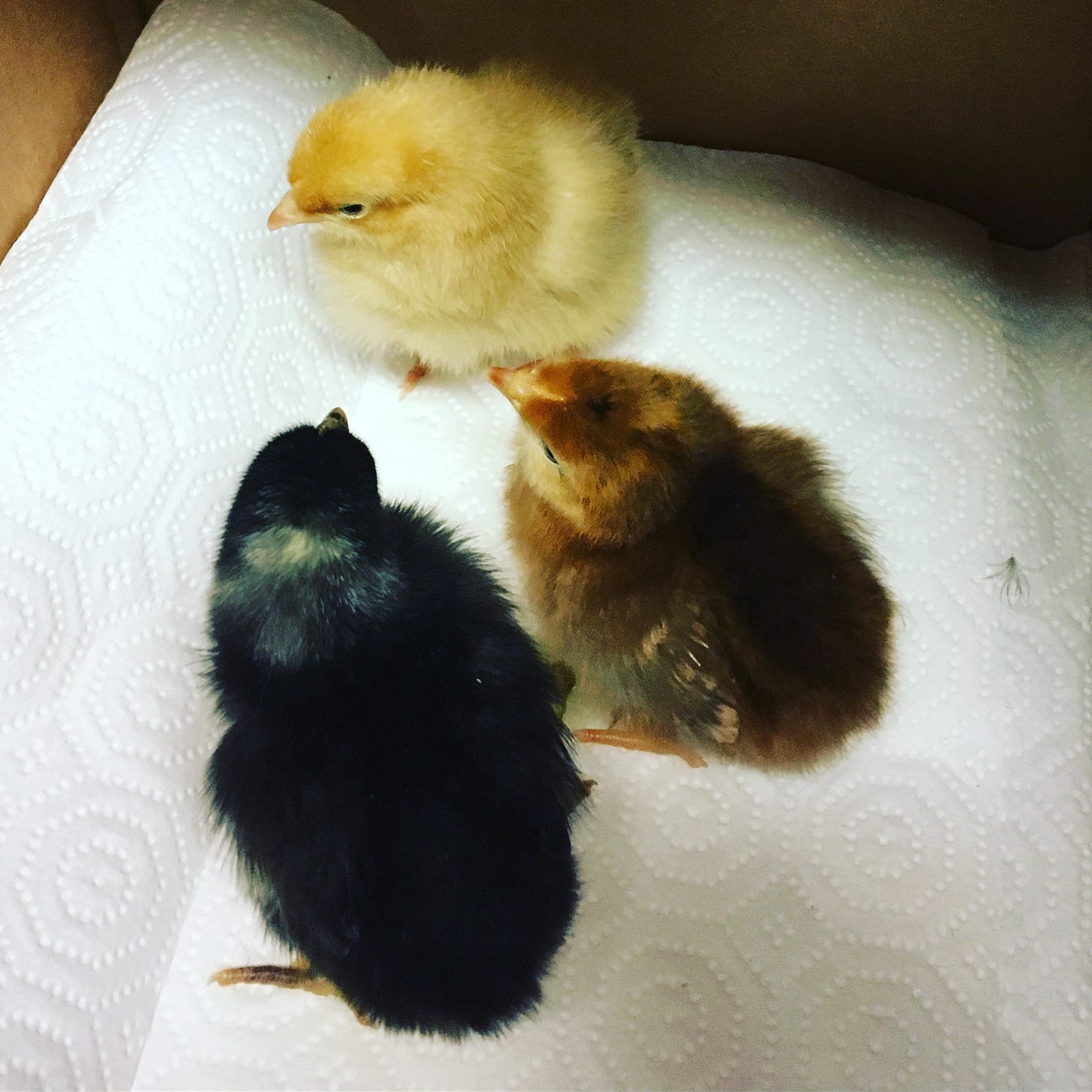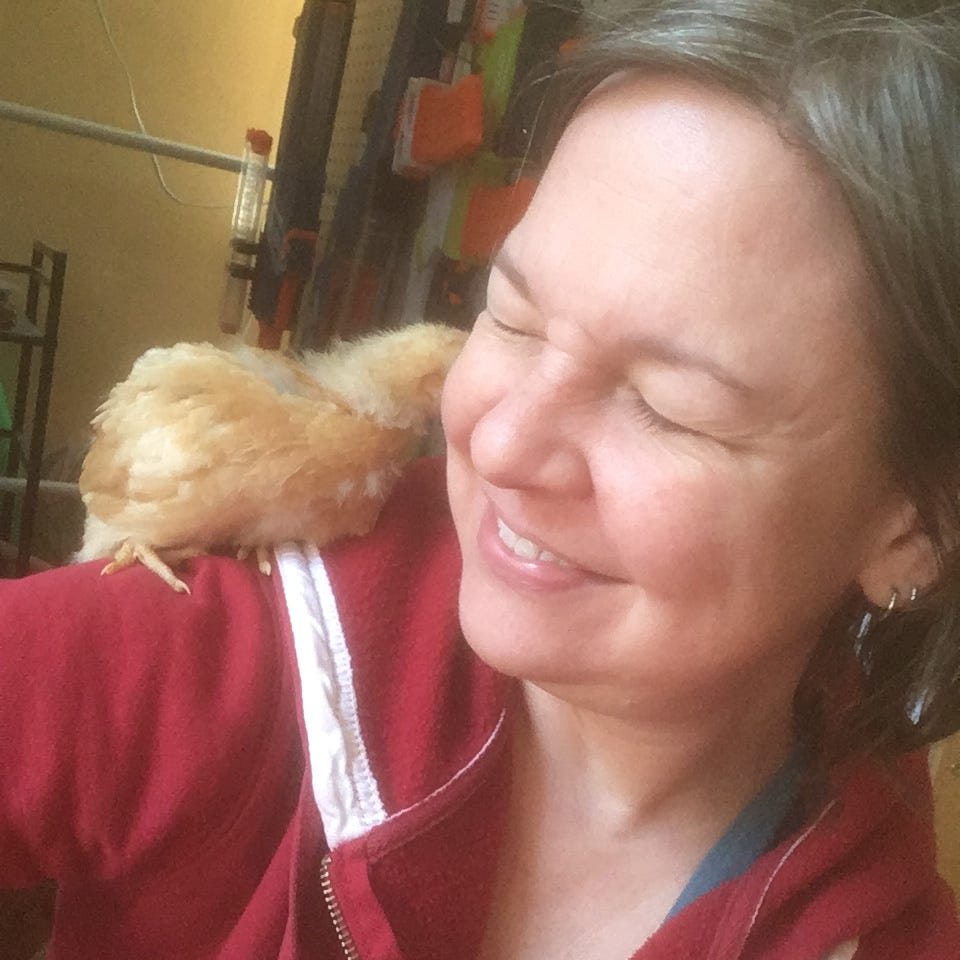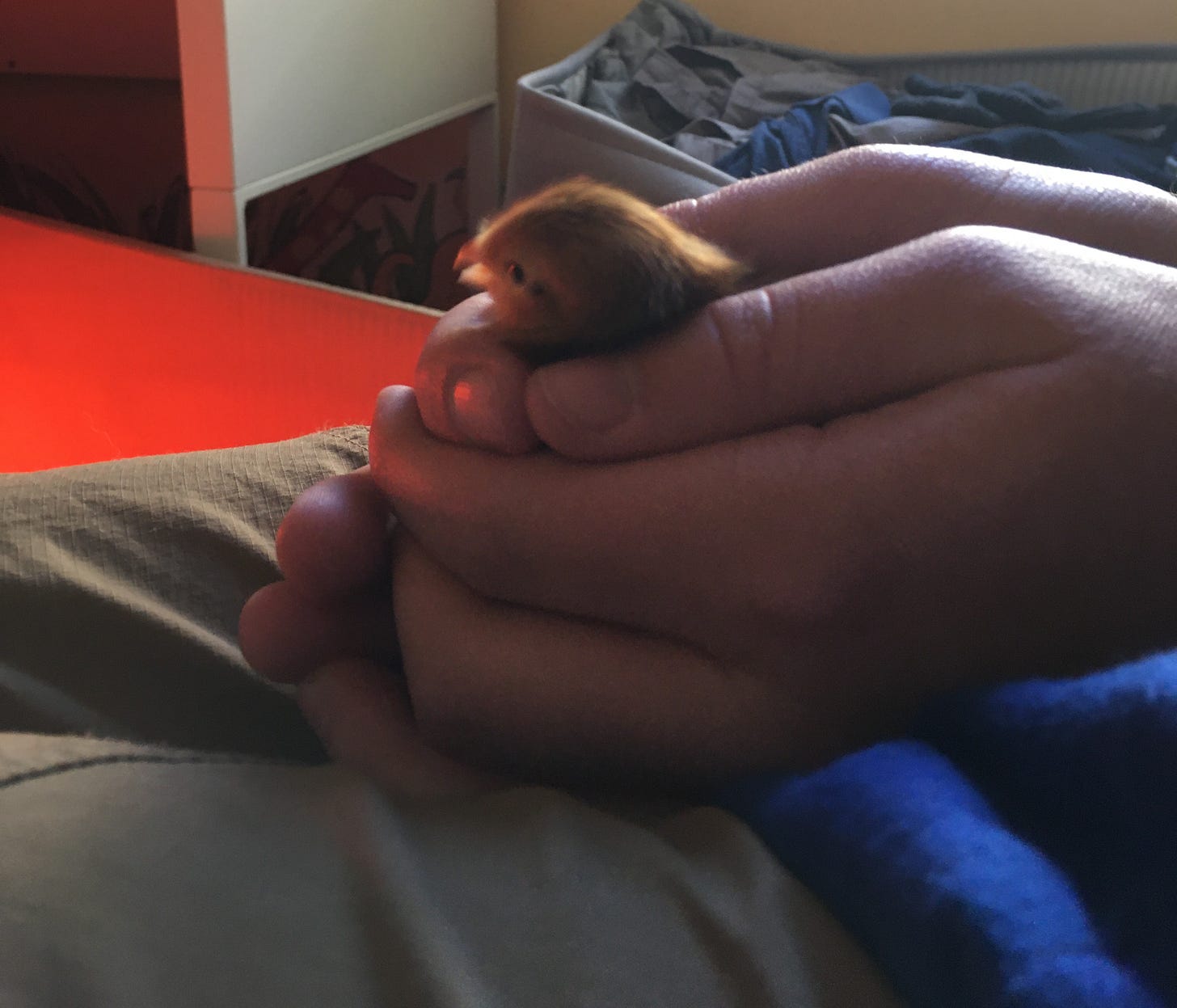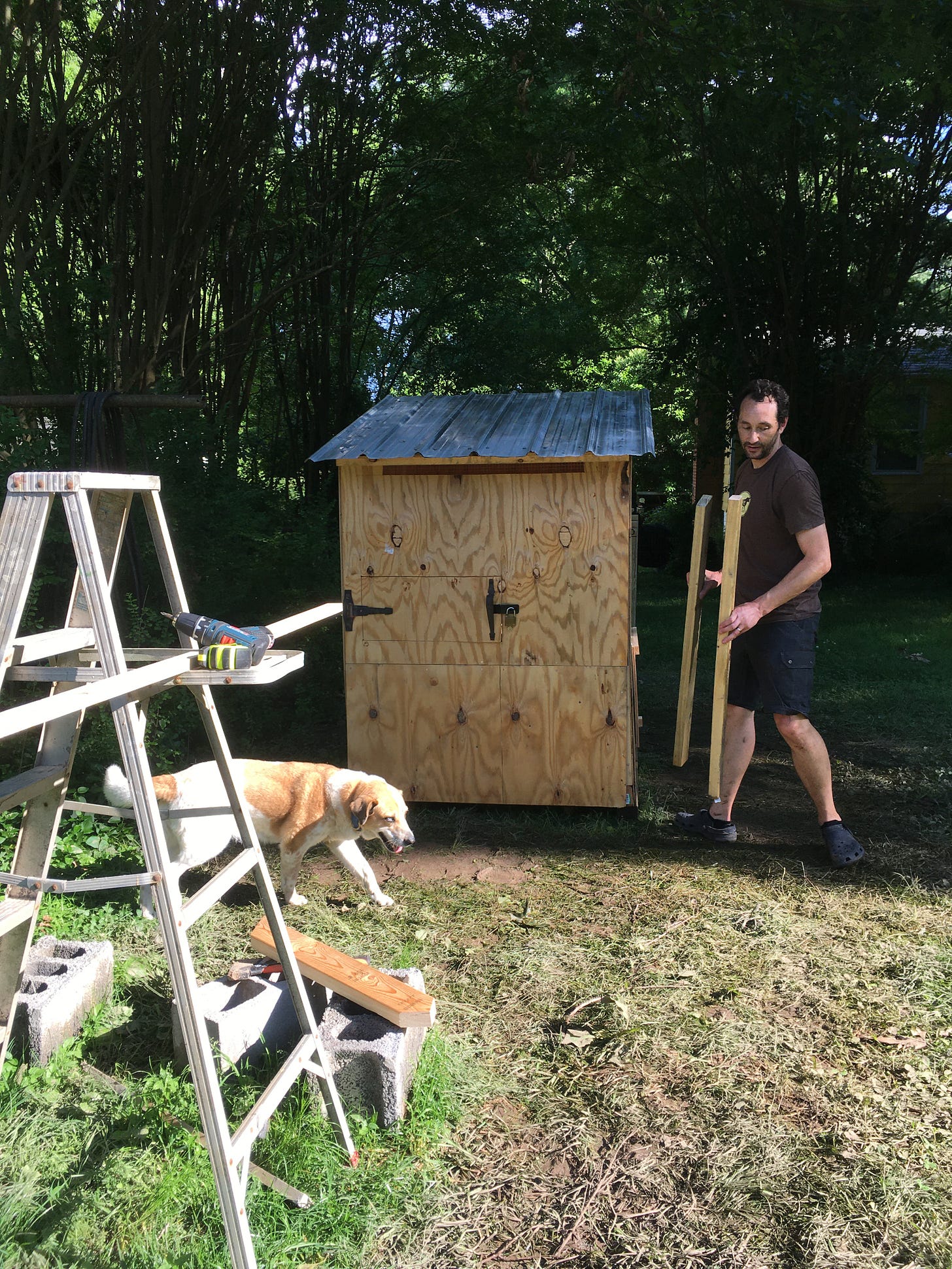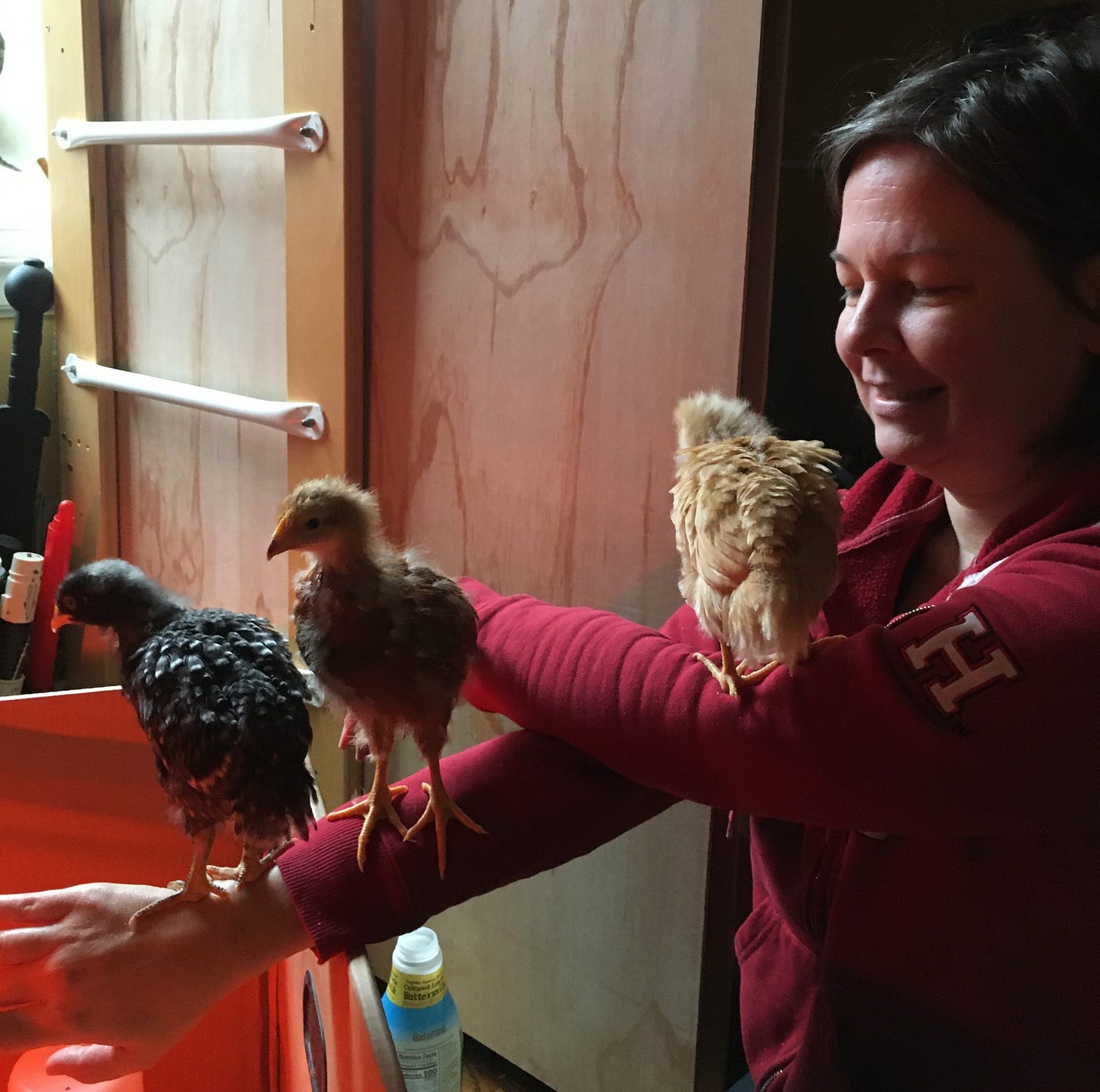The end of our chicken era (maybe?)
Kel died yesterday.
She was the last of the three beloved chickens we adopted in April 2020.
A beautiful Rhode Island Red, Kel loved mulberries, cicadas, and freeze-dried mealworms.
We brought Maggie, Kel, and Buffy home in April 2020.
Our son Sam had been lobbying for chickens for quite some time.
With Covid-19 came a softening of his parents’ reluctance.
The chicks brought joy and delight to a gloomy time. I mean. Just get a load of these three fluffballs:
The three flatmates lived in a box in Sam’s room until they would be big enough for their outside coop (still to be built).
Midway through their first overnight, Sam moved to the sofa couch in the den.
Turns out chicks are no respecters of the clock.
They play and scratch and eat and sip water and loudly cry “CHEEP CHEEP CHEEP CHEEEEEEP” at all times of day and night.
Buffy (full name Buffy the Wormslayer) was a gorgeous Buff Orpington. She was golden yellow, a sunshine ball of fluff growing into a beautiful creature.
Maggie was a Barred Rock, named after Magpies because she was black and white. Unbelievably beautiful, her black and gray fluff developed into cascades of black, white, and gray feathers. Maggie and Buffy loved sitting in our laps. They both made unique-to-them combination cooing-purring sound when you pet them. Kel was more aloof.
We loved holding them. From chick to pullet (teenager) to fully grown hen: they were endorphin releasers, dopamine creators.
To hold a delicate chick; to sit outside with a sweet hen nestled in your lap. Bliss.
To stroke your fingers or the back of your hand down their backs, between their tucked wings, to feel their soft feathers— you haven’t felt velvety softness until you’ve pet a chicken.
Kel (full name Keladry of Mindelan, IFYKYK) was, from day one, the shiest and most aloof of the three, and our alpha hen: she was never mean to her flatmates but clearly in charge and taking no guff. She was also our escape artist. Several times we had to set up a camera to figure out how she was getting out.
The first time one of them laid an egg, it felt like a gift.
I mean a true, miraculous, amazing, gift.
A perfect latte-colored egg, still warm.
Did I cry? Of course I cried.
What we learned from keeping chickens is that
They have individual spirits and personalities and quirks - you could describe a behavior and we could tell you which chicken you meant.
They are beautiful and so, so soft.
They are smart. They recognize our voices and our physicality; they knew who we were where and who did what.
They have different sounds they make at different times of day. Their quiet evening clucks were my favorite.
Near sunset they make their way into their coop, all on their own.
They are wise yet fairly low-maintenance creatures.
Why am I telling you this?
Two reasons.
One, to honor the lives of Maggie, Buffy, and Kel, and express my gratitude for the joy —and eggs— they brought into our lives when we brought them home.
Two, because our chickens, while exceptionally beloved, were not exceptional.
It’s imperative that we be mindful of this.
Every chicken is a full being, personality, quirks, individuality and community.
What I learned from having chickens is that there is no questin in my mind that they have spirits; that they are every bit as whole and beloved by the Great Cosmic Echidna as we humans are.
Which means that every chicken nugget, every chicken breast, every wing or drumstick: they all come from chickens who were as individual and personality-filled as Maggie, Buffy, and Kel.
You know what’s unpopular?
Reminding, or teaching, people that their meat was once a living being.
But I think it’s unpopular because so many of us want find the reality too painful, and our Chick-Fil-A too tempting.
The truth of the message remains whether we ignore it or not: humanity is “farming” and slaughtering animals at incomprehensible scale.
Let’s not ignore it, just for these few minutes.
Let’s stick to chickens.
Every day, humans slaughter 202 million chickens worldwide.
That is 140,000 chickens every minute.
2333 chickens slaughtered every second.
In the United States, more than 9 billion chickens are slaughtered every year.
This comes to 287 chickens slaughtered in the U.S. every second.
The scale is mind boggling.
“Ok. I hear you. But I buy humanely raised poultry and eggs from cage-free hens.”
Friend.
I hate to break it to you.
Unless you’ve been to the farm and seen for yourself,
or you know the farmer,
those terms don’t actually mean much.
“Unfortunately, these labels are often a mirage. … [the chickens are] crowded into enormous warehouses by the hundreds of thousands. Technically that’s “cage-free,” but it’s not a free life.
“[Factory] farms pack in chickens tightly to maximize profits, so a chicken in captivity has very little space and is surrounded by a sea of other chickens…. even farms that claim birds have ‘access to the outdoors’ often pack tens of thousands of birds into a warehouse that has a tiny yard that can fit a dozen of them.”
Worse, “[c]hickens are often [painfully] debeaked to stop them from fighting with other chickens out of discomfort and pain; many cannot turn around their entire lives….”
Oof dah.
Let’s take a moment for a deep breath.
Here are our chickens their first time in their bespoke coop:
Ok.
Another inhale.
Exhale.
Truth is important, even when it’s painful.
We were talking about factory farms. Chickens go from factory farms to the slaughterhouse.
“Once the birds are ready for slaughter—a mere 6 or 7 weeks after they are born—the birds are transported to slaughterhouses on trucks, where many birds suffer bruises and injuries or are crushed to death. Once they reach the slaughterhouse, chickens are shackled upside down by their legs (sometimes breaking their legs in the process), and then stunned by passing through an electrocuted water bath or being gassed. After being stunned, the birds have their throats cut and they bleed out. Some birds are either ineffectively stunned or ineffectively cut, so they are alive and sensible when they enter the next step: the scalding tank, where their bodies are boiled to rid the carcass of feathers. After this, the carcasses are defeathered, dismembered, processed, packaged, and sent to stores. All of this is industry-standard and perfectly legal.“
This “routinely causes extreme harm and suffering to the birds.”
And. There is a human toll.
Humans work in these factory farms and slaughterhouses.
Imagine the physical, psychological, moral, spiritual toll that this cruelty wreaks on our human brethren.
The factory farms: “Exploitation of poultry farmers is … part of the industry’s design. The farmers who raise the birds … cannot compete with these giant integrators by processing their own birds because of market consolidation. Their facilities are often built to integrator specifications, making it nearly impossible to change paths once they enter the business. Nearly three quarters of contract chicken farmers live below the poverty line. Farmers are squeezed by the big producers and exploitative contracts into bankruptcy, leaving them with few options but to raise more chickens more cheaply.”
And the slaughterhouses?
Listen to Susana Chavez talking about her job slitting the throats of chickens at a slaughterhouse.
She says,
“It changed me forever.
“… my first job as a teenager was slitting the throats of chickens at a slaughterhouse. I started off as a “peeler.” I would pluck the feathers from their bodies as they came to me on the line. About 2% of the time, they would still be alive, still moving. Later, I moved on to a new role: cutting throats, which I did 700 to 800 times during my shift from 3 a.m. to 7:30 a.m. before heading to school at 8:30 a.m.
“I was mostly numb to the killing. I didn’t recognize that each of those animals was an individual with a rich emotional life of their own. Occasionally, however, I would recognize their desperate eyes as they would look at me. But in order to do my job, to get through the day, I couldn’t care. It wasn’t until decades later, when I saw a video online of a chicken being killed that I came to grips with the disturbing reality of mass killing.
“In addition to being the most dangerous profession in the United States, a 2016 study showed that slaughterhouse workers face higher rates of psychological distress compared to the general population. It is unnatural and inhumane for someone to kill for hours every day. The lasting trauma experienced by slaughterhouse workers is similar to that faced by combat veterans and disaster survivors and leads to high rates of drug and alcohol abuse, and domestic violence.“
Other workers report horrific smells, experiences, conditions in slaughterhouses:
“Workers report a lack of breaks, even for the bathroom. Injuries often result from the repetitive motion required for a single job on the processing line (e.g., twisting and slicing wings off a carcass), and overusing dangerous equipment has even resulted in amputations….
“Moreover, many slaughterhouse workers are undocumented immigrants or minorities, which exacerbates many of these problems. These workers are far less likely to organize or complain about injuries or poor work conditions, either because of a language barrier or fear of losing their jobs, or both.”
And as if that’s not bad enough: meat production has a terrible toll on our planet.
94% of non-human mammal biomass is livestock. This means livestock outweigh wild mammals by a factor of 15-to-1. This share is 97% when only land-based mammals are included.
71% of bird biomass is poultry livestock. This means poultry livestock outweigh wild birds by a factor of more than 3-to-1.
And the carbon footprint is no joke.
You can read more about the environmental impacts here.
Look. I’m not telling you what to do.
If you want to eat chicken, eat chicken.
What I ask is that we don’t lie to ourselves.
What I ask is that we be honest.
Don’t deny the truth: the Chick-Fil-A sandwich was once a living creature, as belove by the Great Cosmic Echidna as Kel, Maggie, and Buffy were to us.
Too, the farmers and slaughterhouse workers are our neighbors. They are suffering from this industry.
So what do we do?
One thing I always recommend: check in with your core values.
What are your core values?
What are your hopes for this world?
Is all this industrialized suffering, in this gigundor mass scale, in alignment with your values and hopes?
If “you are what you eat”— what does that make you?
What does that make us?
What are we eating? Suffering? Degradation? Cruelty?
Are we good with that?
If not, what changes are we willing to make?
What could be our first step toward that change?
Let’s start there.
Written with gratitude for
and in remembrance of
our sweet Kel, Buffy, and Maggie.
Thank you, dearest ones. For your company, for your teachings, and for your eggs.
May the Great Cosmic Echidna embrace you
and provide you mulberries to your hearts’ content.
XOXO




